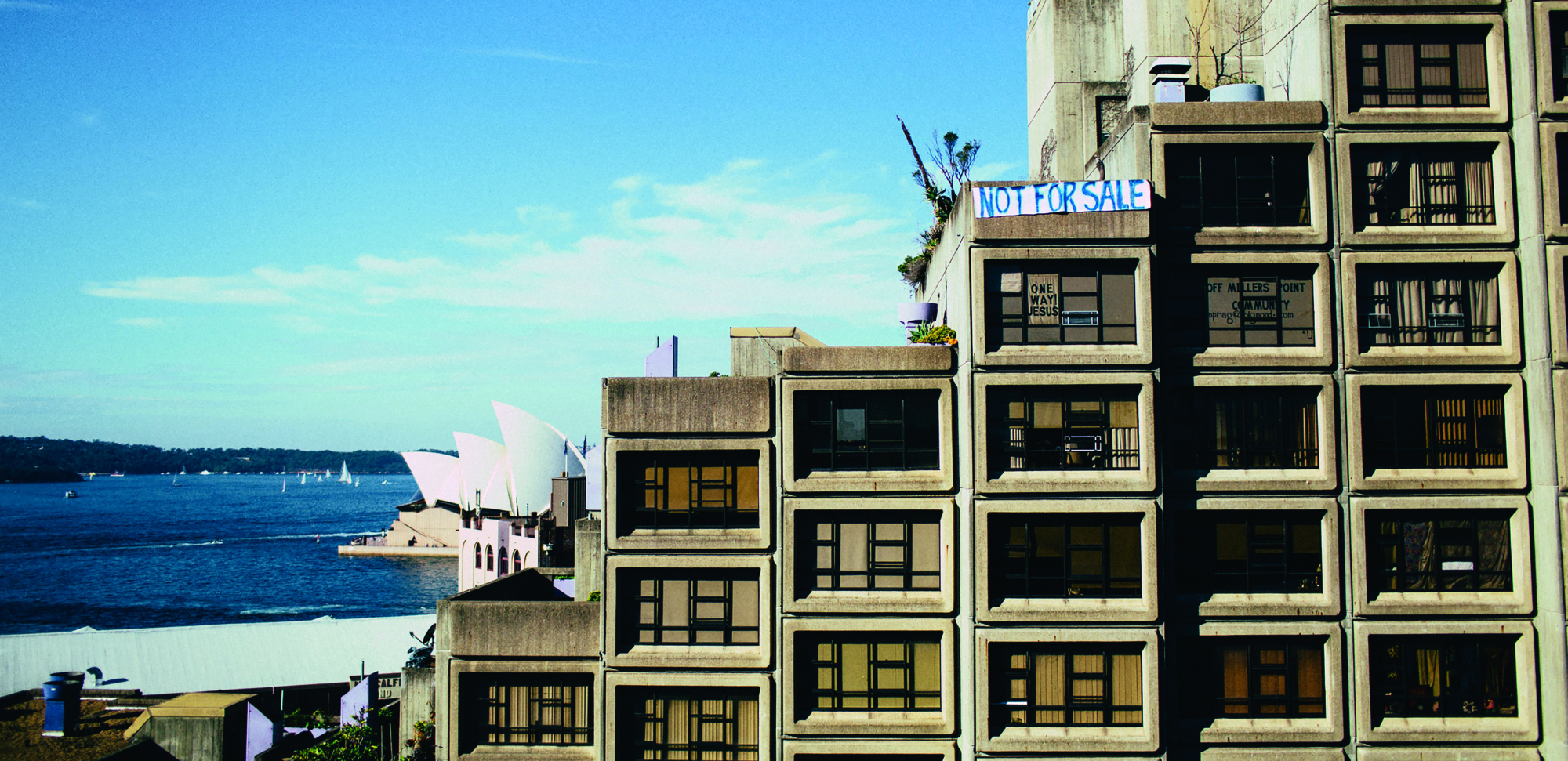‘It was a film that everybody was telling me to stop making, the whole time I was making it,’ says director Blue Lucine, referring to her documentary The Eviction, which premiered at the 2018 Antenna Documentary Film Festival. ‘People would say, “No-one’s going to watch it,” or, “The story’s already over.”’
The seed for The Eviction was sown on the evening of 19 March 2014. Lucine was having dinner with friends shortly after the New South Wales (NSW) Government had announced it would sell 293 public-housing properties in Sydney. These included the famed Sirius building, made in the brutalist style, as well as other dwellings in Millers Point, Dawes Point and The Rocks. The sale would affect 579 tenants, who received two years’ notice to relocate.[1]See Alan Morris, Gentrification and Displacement: The Forced Relocation of Public Housing Tenants in Inner-Sydney, Springer, Singapore, 2019, p. 1. Lucine recalls:
My friends knew elderly people who lived in Millers Point. They were distraught, wondering […] how it would impact everybody. Meanwhile, most of the media was presenting a different story: That the tenants were bludgers who lived in a rich area. That they should be kicked out, and it would be a really good thing for the rest of NSW. The simplicity of that made me question what was really happening and why.
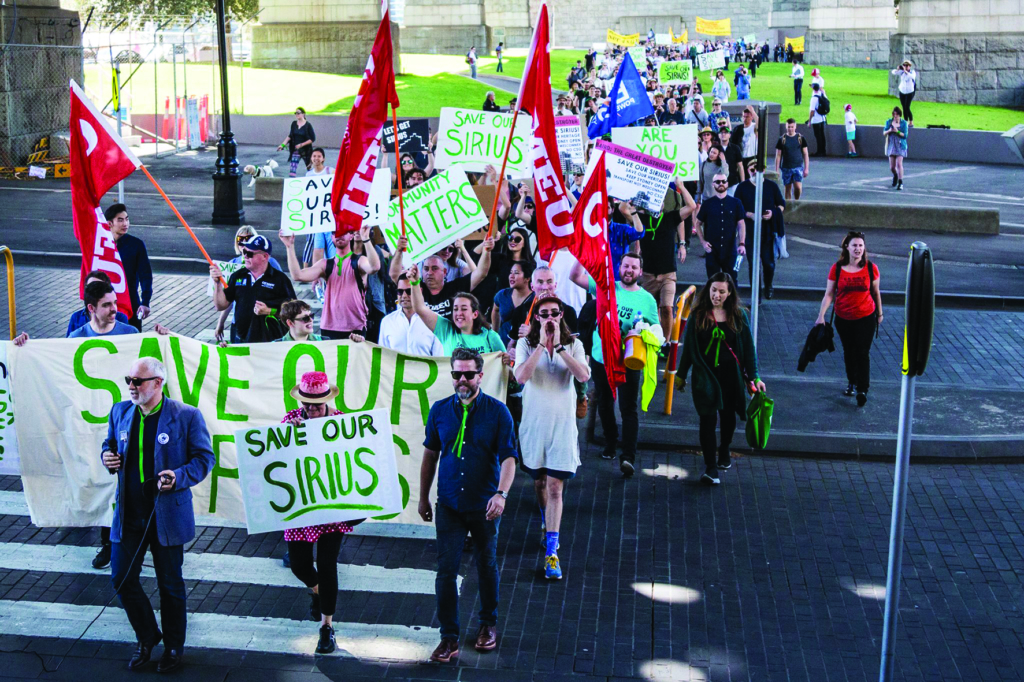
By 22 March, Lucine had borrowed a camera from a friend and begun filming. Her first stop was a public meeting at Abraham Mott Hall, Millers Point. Convened by Alex Greenwich, the independent Member for Sydney in the NSW Legislative Assembly, the event attracted more than 300 local residents. ‘It was like a mass wake,’ Lucine recalls.
The hall was filled with people sobbing and holding each other. I was introduced to ninety-year-old women who were saying to me, ‘I’ve lived here all my life. What’s going to happen to me?’ The contrast between that and the headlines was so stark […] For a government to make a decision on a grand scale, that has a huge impact on the individual, but [which] isn’t represented as such, I find that really dishonest – not as a public-housing tenant or even as a resident of Sydney, but just as a human being.
The Eviction traces the four years from this meeting up to 1 February 2018, when the Sirius building’s last remaining tenant, the legally blind 91-year-old Myra Demetriou, moved out. Lucine narrates the events of this period from Demetriou’s standpoint and those of four other local residents: Barney Gardner, Bob Flood, Molly Clark and Cherie Johnson. Their personal histories and emotional journeys interweave with their fight against their eviction, a fight galvanised by sympathetic politicians and public figures and pursued at all levels – from grassroots protests to legal action against the NSW Government.
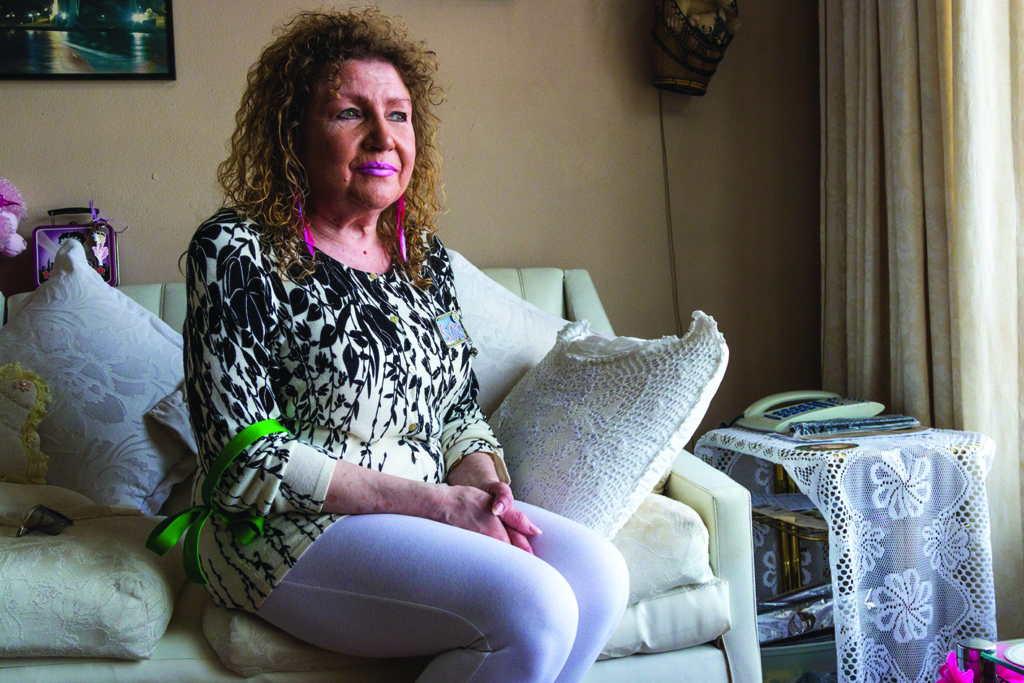
‘I chose the subjects I did foremost because of the relationships,’ says Lucine.
When I started filming, everybody else was filming at the same time. A Current Affair was trying to get stories. Reality-television shows were looking for content […] As someone three months out of film school, it was really daunting. I couldn’t compete. I couldn’t promise anything. So my strategy was to be as honest and open as possible. The relationships I formed ended up being really, really strong. They’ve stood the test of time.
The resulting intimacy enabled Lucine to travel deep into her subjects’ worlds. The first individual we meet in the film is Flood; his face fills the screen in an eye-level close-up. ‘My name is Robert William Flood,’ he says to-camera, his gaze unflinching. ‘I’ve lived in Millers Point all my life. I’m sixty-four years of age.’ As the camera cuts to a black-and-white photo of two toddlers holding hands, Flood reveals that his connection to the area spans generations. ‘My mother and father lived here. Grandmother, grandfather, lived up The Rocks.’
The same is true of Gardner, a childhood friend of Flood’s, born in 1949. ‘I came home from hospital to number 12 High Street, which is next door,’ says Gardner. ‘So I’ve been in this area for near on sixty-five years.’ The two recall swimming and fishing in Sydney Harbour together. Both are also friends with then-ninety-year-old Clark, who’s lived in Millers Point for six decades.
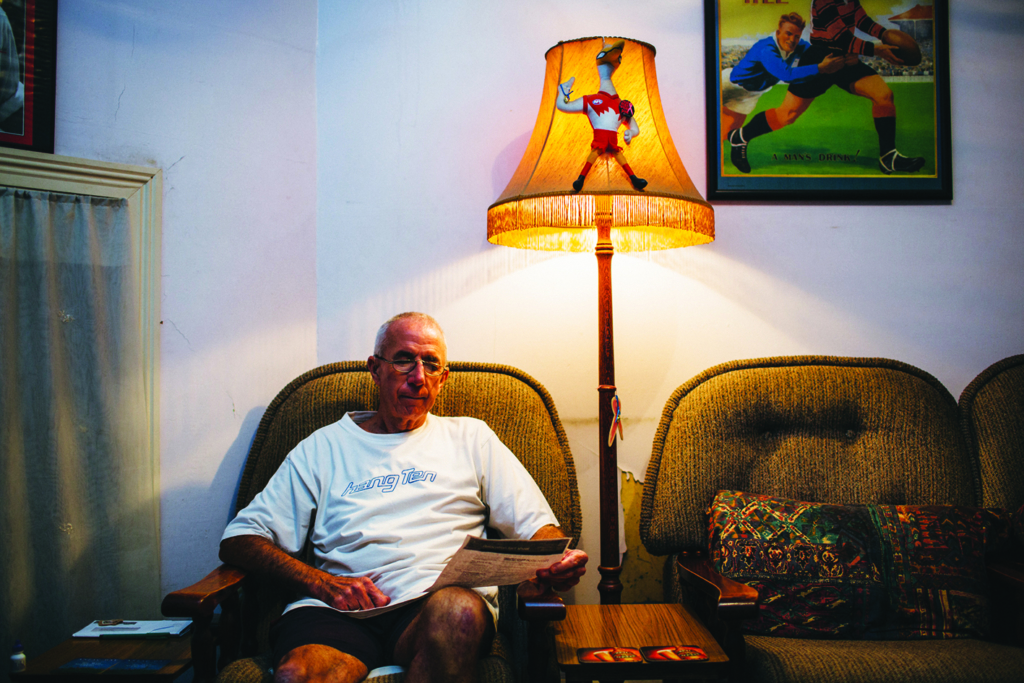
Then there’s Johnson, one of the first residents of Sirius, an apartment complex built and owned by Housing NSW (formerly the Housing Commission of NSW). Completed in 1980, its purpose was to rehouse tenants displaced in the 1970s following a redevelopment of The Rocks.[2]See ‘Sirius Building | 1975/1980 | NSW’, DOCOMOMO Australia website, <https://docomomoaustralia.com.au/dcmm/sirius-building-1975-1980-nsw/>, accessed 26 February 2019. In the film, Johnson recalls the signing of the lease: ‘Mama said, “Before I put my signature to this, if I pass away, what’s going to happen to my daughter?” And they said, “Don’t worry. It’s your home for life.”’
Framing the subjects’ stories is a voiceover by Australian actor Michael Caton, perhaps best known for his role as Darryl Kerrigan in The Castle (Rob Sitch, 1997), a fictional film about a working-class family who, threatened with eviction by the government, pursue their case all the way to the High Court. His opening line in The Eviction evokes this cinematic lineage: ‘A bloke far smarter than I once said, “A man’s home is his castle.” But he didn’t live on the Point.’ Beyond its intertextual allusions, Caton’s narration provides context about the area, recounting events that not only tie Lucine’s subjects together, but also played a key part in Australia’s industrial development. ‘Millers Point has a rich maritime history,’ says Caton. ‘From the 1820s, the Maritime Services Board built houses for workers and their families – a short commute to compensate for gruelling twenty-four-hour shifts.’ Black-and-white archival footage cuts between mammoth-size cargo ships arriving at the wharves and men hard at work lifting wool bales and shovelling.
This historical evidence gains colour and emotional resonance from Flood’s and Gardner’s recollections of their fathers, both of whom worked on the wharves. Interspersed with close-ups of the men reminiscing are family photographs. ‘My old man started as a blacksmith, then he went to war,’ recounts Flood.
He went to the Middle East and New Guinea. He was a nervous wreck when he came home […] They used to call him ‘The Nerve’ – that was his nickname. He went on the wharves. Pretty tough times, working […] in his days. Very tough times.
Not all of the subjects’ memories are about hardship, however; also forefront of their minds are images of a close-knit community. ‘If a family didn’t have enough food or they didn’t have enough money to pay a bill,’ Gardner says, ‘or they needed something done to a house, the whole community would pitch in.’ In a similar vein, Flood recalls, ‘Everybody was so close. It was like a village, which it was. Everybody trusted one another, helped one another. They all stuck together around here.’ Through these testimonies, Lucine carefully crystallises the idea that the eviction represents not just the removal of 579 individuals from public housing, but also the destruction of a longstanding community bound by deep genetic, cultural and social ties.
For the filmmaker, this sense of community is epitomised – both historically and at the time of filming – by Clark. ‘I met Molly through Bob, [who took] me around to her house. The first day, I felt like I was visiting my nan,’ muses Lucine.
She gave me Monte Carlo [biscuits] and a cup of tea, and started giving me life advice. She represented something that felt so special to me and that doesn’t get seen a lot […] Molly was like all of Australia’s grandma – like everybody’s nan.
Another aspect of this generation is represented in Demetriou.
The irony of Myra’s story was quite strong. She had this beautiful view that she couldn’t even see. She’d worked all her life for the city and, now, at ninety years old, she was getting turfed out. Her struggle was something that anybody could go through. She also represented […] that stoic generation of really loving women who were so capable and took care of everybody and had this steely resolve. She’s a really funny, feisty lady, and someone I really look up to as well.
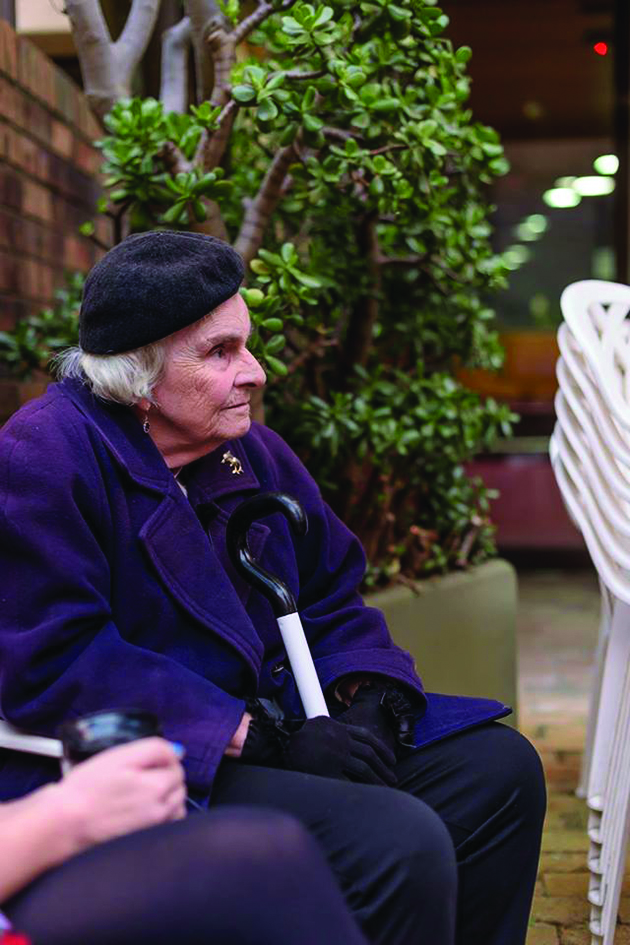
The Eviction paints the tenants’ relationships founded on intimacy and trust in stark contrast to the government’s focus on the properties’ monetary value. Just after Flood states, ‘It was like a big bloody family,’ the camera cuts from his lounge room to long shots of the Sydney Harbour Bridge, foregrounded by leafy trees. Percussive music hastens the pace as Caton’s narrative enters: ‘Being smack-bang in the middle of Sydney, The Rocks is prime real estate – and, despite its social and cultural significance, from the 1960s, it’s had the eye of developers.’ Indeed, rather than an isolated or new event, the subjects’ fight is the continuation of a struggle between the NSW Government and public-housing residents that has gone on for decades.
The viewer meets Jack Mundey, a renowned anti-development campaigner. Archival footage shows him being carried off by police in the middle of a frenetic protest. Sitting in his lounge room in the present day, but speaking of the 1970s, he asserts in the documentary:
The Rocks was a turning point, where they put the brakes on the wholesale development of Sydney. I think all the approaches to the bridge – all that area of eastern Sydney – would have been destroyed. The workers who were going to build these giant buildings were the ones who were staying, ‘Stop. All development is not necessarily good.’
Like these workers and the past tenants they fought for and beside, Lucine’s subjects are not mere victims. They might be at the mercy of a government decision that endangers their homes, but they are far from accepting of it. In this way, The Eviction is as much a study of fierce, determined and multifaceted activism as it is of the values and personalities of its subjects.
In fact, when the filmmaking process became challenging, Lucine found strength in their courage:
When you see people like Bob and Myra and how hard they fought, bearing witness to that, I could never justify giving up, just because it was a little bit difficult. I think that’s something that’s unique about documentary. Your participants are the thing that inspires you to finish. You’ve taken on their story, and they’ve shared so much of their time and energy with you. So it’s your duty to get it out there.
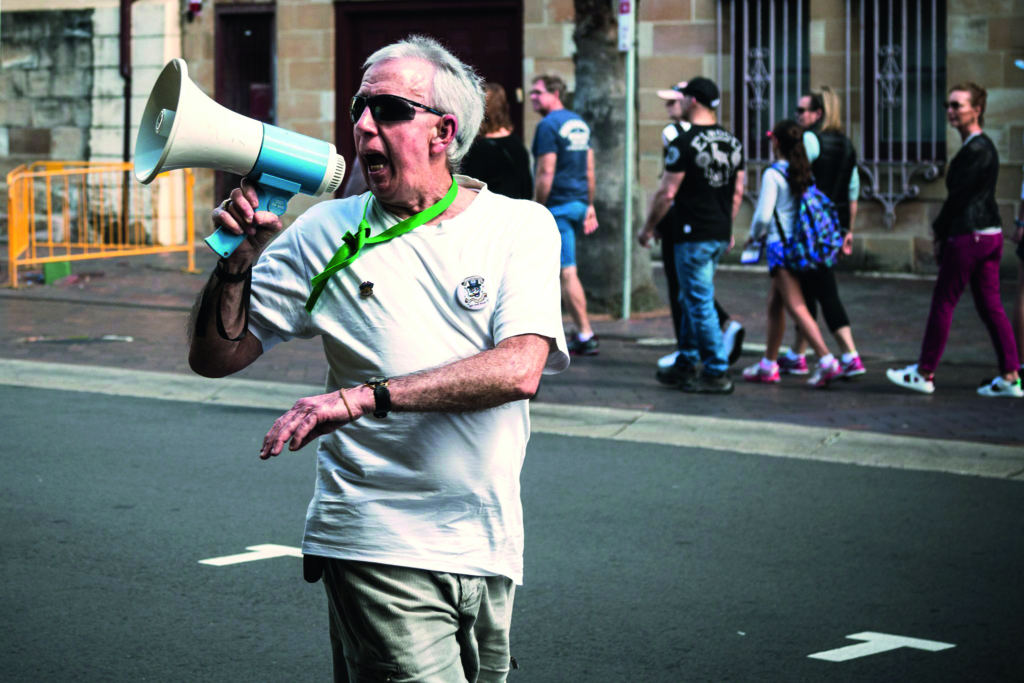
This courage is established in the opening scenes, with footage of various tenants expressing their opposition to the eviction, loudly and clearly. Early in the film, an unidentified man sings ‘Waltzing Matilda’ a cappella before turning around and yelling, ‘Bugger the housing commission!’ Another fronts a crowd, declaring, ‘This is not about one home. This is not about one street. This is the social cleansing of an entire suburb.’
Their initial protests, as the film reveals, turn into a four-year-long campaign, executed across an array of fronts. Sheets scrawled with handwritten messages such as ‘No surrender. Millers Pt. Not 4 Sale’ hang from verandahs. Small groups of tenants stand outside real-estate agents’ offices shouting appeals to conscience. A line of protesters covers the footpath outside the NSW Parliament on Macquarie Street, Sydney, their bright, multicoloured umbrellas suggesting hope against a grey sky and pouring rain. Hundreds of people march through Sydney’s CBD, joined by Lord Mayor Clover Moore and NSW opposition members, such as then–shadow planning minister Michael Daley. The decision of the state government not to list the Sirius building on the State Heritage Register – despite the recommendation of the Heritage Council of NSW – leads to a case in the Land and Environment Court.[3]Morris, op. cit., pp. 19–20.
By complementing her documentation of the subjects’ activism with statements of fact, Lucine demonstrates the contradictions in the NSW Government’s policies. For instance, the viewer witnesses Minister for Social Housing Pru Goward’s public announcement that the sale of Sirius is for the overall benefit of the state because the money will go towards the construction of new properties. Soon after, however, Caton reveals some disconcerting data: as of 2014, 57,000 people in NSW were waiting for social housing, yet 1500 houses and apartments remained vacant. Adding a human perspective to these startling figures are Flood’s observations. After leading Lucine to a concealed area behind Clark’s house – which is in a woefully dilapidated condition, filled with rubbish, broken wood and overgrown plants – he explains:
The Maritime Service had their own workers. They had their own plumbers, electricians […] and they used to keep it right up to scratch. As soon as the Housing Commission took [Millers Point] over, it started falling down, down, down, down, down, until it’s got to now – they’re doing nothing, really.
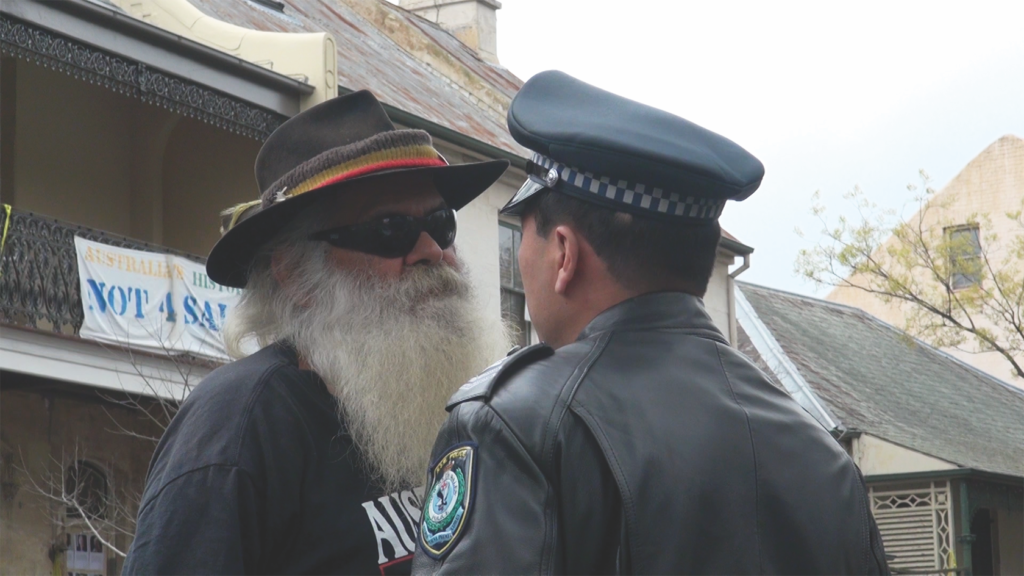
The implications that this might suggest a more insidious plot on the government’s part find backing in the comments of then–deputy lord mayor Robyn Kemmis, who also appears in the documentary: ‘Well, it suggests that the thought of selling the whole estate in Millers Point has been on somebody’s table for some time.’
The Eviction is a brave and conscientious documentary that burrows deep into one of the most controversial NSW Government decisions of the twenty-first century. The four-year journey Lucine takes viewers on – from eviction notice to the final resident’s departure – offers both poignant, perceptive character studies and an astute chronicle of a powerful political campaign that began with the anger and resistance of a few. ‘None of the people I filmed were “Woe is me”. They’d all had really difficult lives, even before this happened. They’d struggled,’ Lucine says.
Yet, despite that, they didn’t play the victim card […] Every single one of them, in any way they could, fought. I wasn’t telling the story of a whole community of victims. I was making a film about a community fighting against everything to try and stay – and, to be honest, I didn’t think they’d lose.
Endnotes
| 1 | See Alan Morris, Gentrification and Displacement: The Forced Relocation of Public Housing Tenants in Inner-Sydney, Springer, Singapore, 2019, p. 1. |
|---|---|
| 2 | See ‘Sirius Building | 1975/1980 | NSW’, DOCOMOMO Australia website, <https://docomomoaustralia.com.au/dcmm/sirius-building-1975-1980-nsw/>, accessed 26 February 2019. |
| 3 | Morris, op. cit., pp. 19–20. |
